Saturday is not affecting the number of Japanese in Shinjuku train station. To navigate this station is like to swim in strong currents. It is easy to be caught up in the flows oof people. I follow the red colour and am just in a carriage in the direction of Tokyo. Shopping is not for a man but Ginza is a district that should not be left undisturbed during a serious trip to Tokyo.
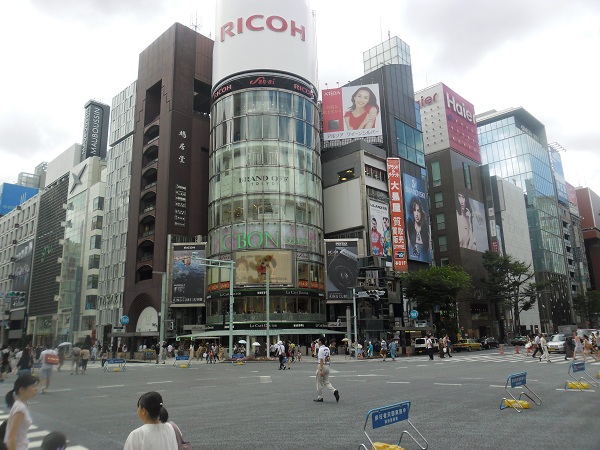
Ricoh, recognized brand for us copying freaks.
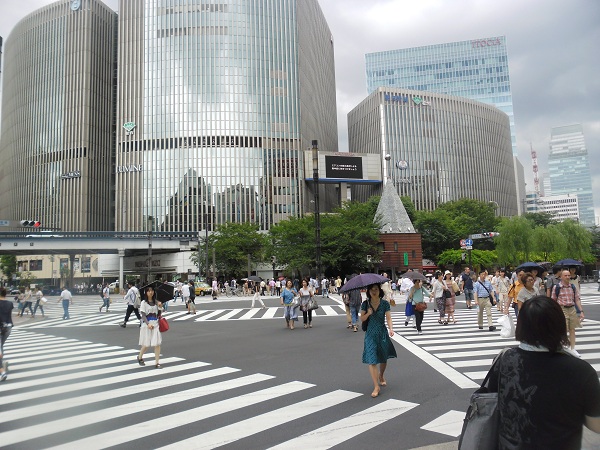
Japanese ladies hide from the sun and cross a street in Ginza.
Ginza impress even an old experienced traveler. Sony's display center takes an hour to walk through. Not a gadget is for sale, everything is just a show. A laptop and air conditioning will be the greatest benefit. After an odyssey of digital gluttony I tumble back into the street. The Sony building is directly adjacent to a dear old friend, Sotobori dori. Sotobori is one of Ginza's larger pulse incurs only a few meters from where Sony digital palaces roars right into Harumi dori. These two streets form a junction which initially gives an impression that chaotic anarchy and lawlessness seem to be the watchwords. They have also managed to squeeze in a railway track 10 meters in the air. In Japan all vehicle types are crowded into the same intersection.
After a while of watching the traffic situation, I start to discern the Japanese art of engineering at its best. Nothing is left to chance. Every movement in this intersection is controlled up with efficiency and precision that would make Swiss watchmaker to close down their shops in sheer despair. It will not be long before I navigate the intersection as native Japanese.
I follow the railroad aimlessly for a while before I slip into a small mall. I am starved as I tumble down to a lunch place. As usual, I point on a dish that is both filling and give the taste buds a satisfaction that they now start getting used to. Cold noodles and wok is not a bad lunch. If it is the Japanese energy policy or old food traditions that have given the Japanese a penchant for cold food remains to discuss. But it is, without a doubt, tasty.
I am, despite the cold noodles in the stomach, no plans and zero track of where I am, feeling fine. I wander around a bit aimlessly until I encounter Harumi dori. I let Harumi take me to the river. A vague memory reminds me of one of the world's largest fish markets are somewhere in the vicinity of Harumi.
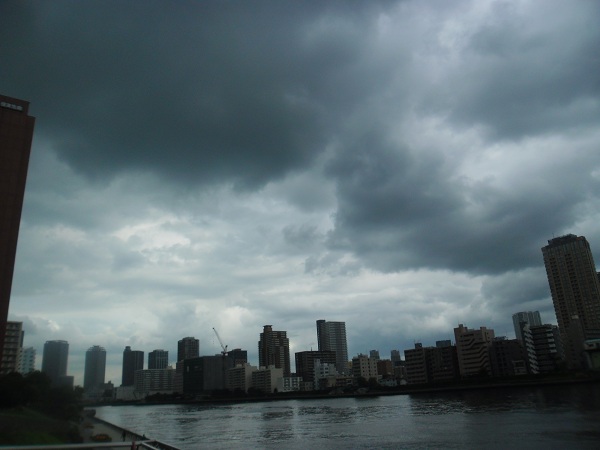
Bad weather is approaching.
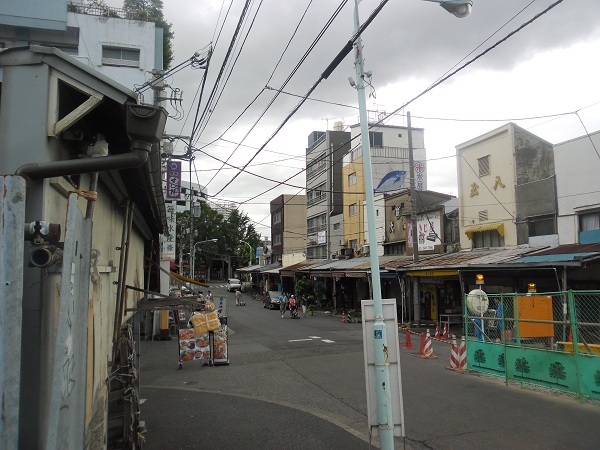
Shabby docklands near the fish market.
Soon I´m standing looking out over the Arakawa River, which later proved to be completely wrong. The water was only a tributary of the Arakawa, or a man-made or perhaps slightly elongated port area. It's not easy to know because the Japanese dig, build and construct the entire Tokyo Bay according to their own taste.
The fish market is closed since the early morning. It is nothing which depletes particularly hard on my mood as the market most resembles one large industrial complex. The market will be left; instead, I continue my aimless wandering in the port area among fishmongers and heavy fishing industry. An unexpected feature of fishing atmosphere pops up in front of my shoes. A small temple with some praying Japanese attracts my interest. A woman pulls a thick rope, claps her hands three times and bows. For a moment I´m thinking of doing the same, but I let go of those religious incursions.
When the fish smell has irritated my nose long enough I start to get in position to bring order to my life and plan up the last hour of daylight this day has to offer. I sit down and look through my guidebook. A page with Tokyo Tower reveals itself in my lap. Well, why not?
The metro and a short walk take me to the Tokyo Tower. Sometime after the war, the Japanese glanced at Europe and drew inspiration from Paris. A tower identical to the Eiffel Tower was easy for enterprising Japanese to build. Obviously it was built higher than the model, and to hide the plagiarism was painted red. Among Tokyo's skyscrapers the tower seems a bit petty, but that does not stop me from making a visit.
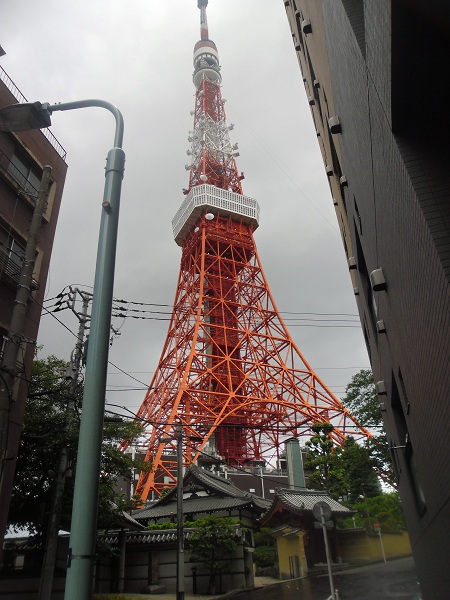
Tokyo Tower, a few meters taller than the Eiffel Tower.
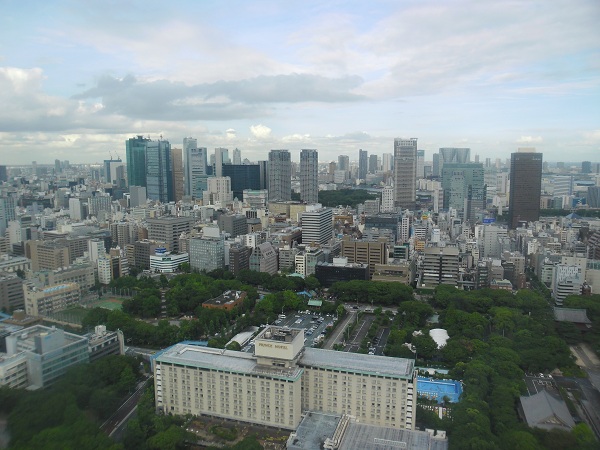
View from Tokyo Tower.
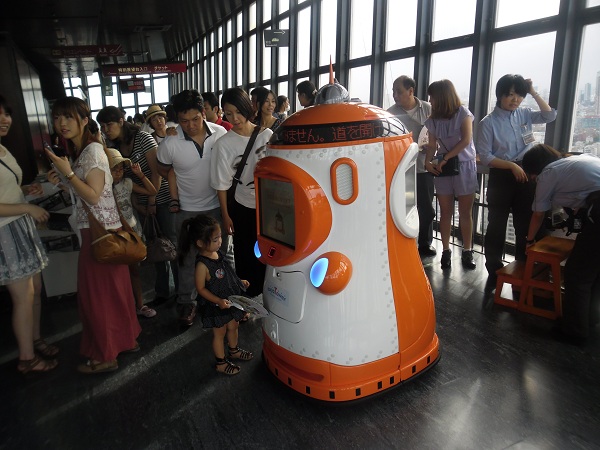
A robot hanging out with the kids.
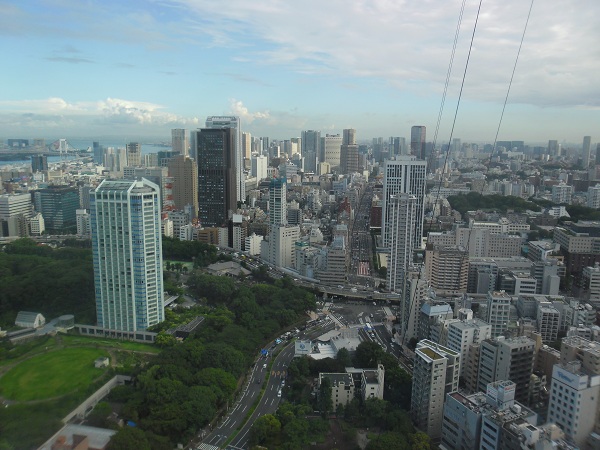
A sea of water behind a sea of houses.
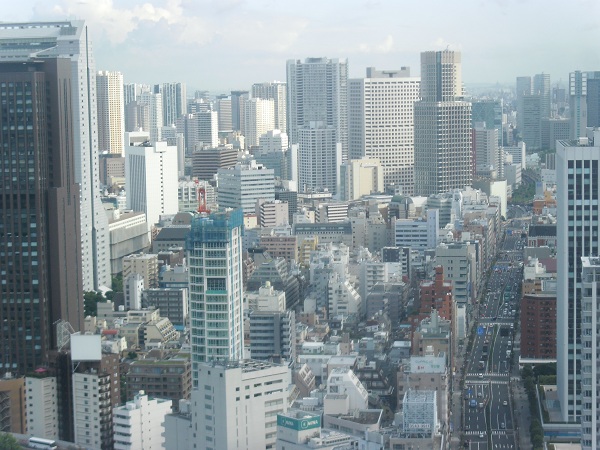
Tokyo
Before the actual ascent I do treat myself a juice on the ground floor. The heat begins to take its toll on the man's body. After a few laps among souvenir shops and sightseeing Japanese I buy a direct ticket 150 meters up to the tower. Despite reduced visibility, it is an impressive view. The skyscrapers will never end in any direction. I'll take some photos and try the best efforts to cover up all directions with my camera. It takes no effort, so happiness will be great when it finally becomes a vacant slot on a bench. I pinch myself down next to a family and feel like one of the gang. It is of course difficult to follow the conversation, but comfort is still high. Confusion of tongues makes me leave the family discussions and I thoughtfully start looking at a robot that slides around and converse with some children. Why? For the technology exists and that this is Japan.
The journey back to Shinjuku is on routine in the metro system which now feels homely and simple. However, I come across some trouble at the train station where it took me 40 minutes to find out the correct way out. I am running out if stamina when I reunited with my capsule. The washing procedure is the same as last night, plus a hefty plate of sushi, before the blind down in my capsule.
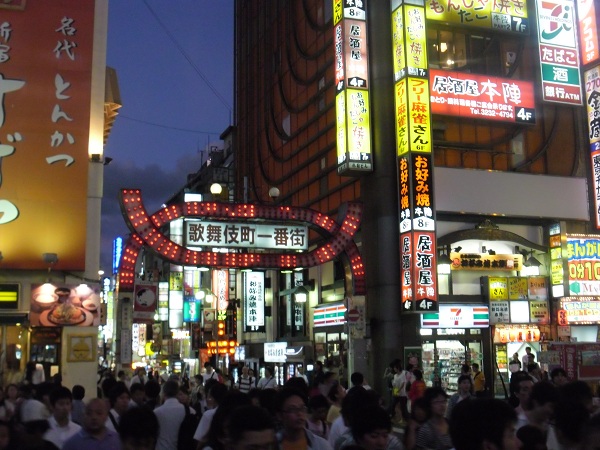
Shinjuku enertainment district.
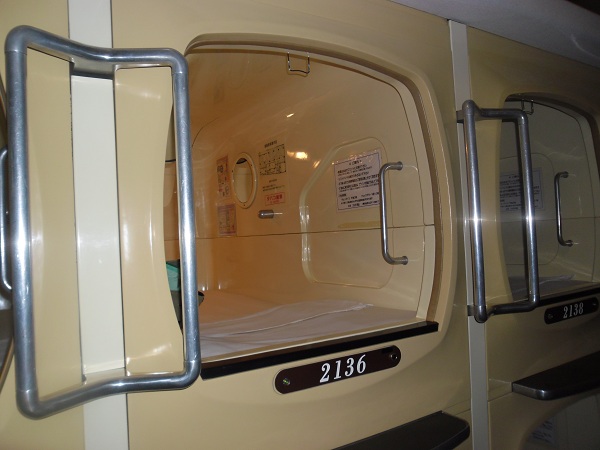
Back to bed!
Sunday 5th of August
I am back at Starbucks Coffee for breakfast. The coffee is tasty while the colourless industrial sandwich does not even make an attempt to challenge the taste buds. Beside me sits a large group of Japanese people with notebooks, pens and coffee cups in meticulous order. It turns out that they are on some form of coffee education. I'm trying to suck in some free knowledge, but soon give up. Despite several days in Japan, my knowledge of Japanese is still modest.
I abandon the Japanese study group and focus my thoughts on the map. I need to make plans for the day and find my direction. My eyes catches a larger park area, Ueno. Ueno looks to be a recreational area for stressed Japanese people who want to escape the concrete everyday. My reasons to visit it are more diffuse and impulsive.
Several days of occupation of the metro makes the underground traffic less difficult to navigate than the escalator at the mall. Ueno station is one of the largest in Tokyo, but in comparison to Shinjuku only a dwarf. It is the end station of the orange line and Ueno Park is in close proximity. These are the conditions that would make even a blind man find it without a cane.
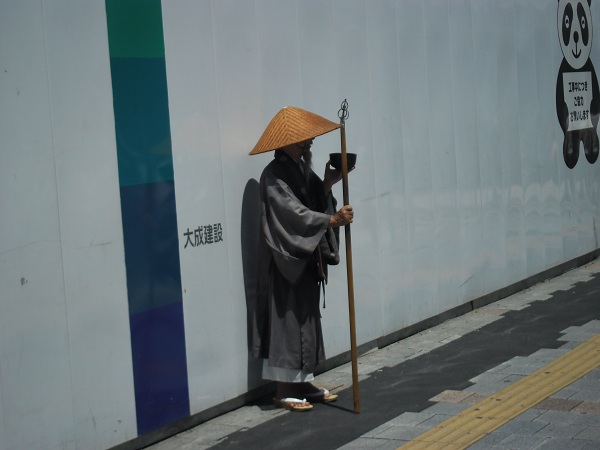
No more money!
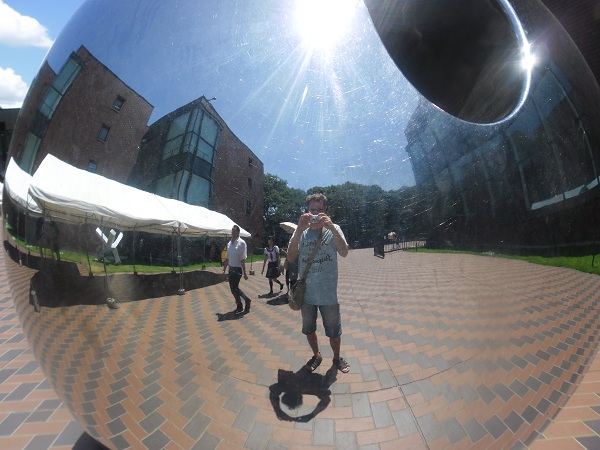
A global photo.
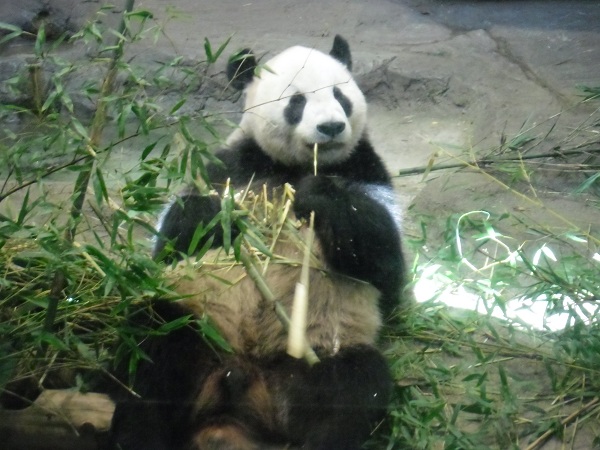
Even a panda needs a toothpick.
The heat, sun and humidity show no mercy. The park visit is, despite this, pleasant and relaxed. Gone are skyscrapers and urban security. Casual Japanese roam and seem to enjoy their day off. The park offers advanced culture in the form of an art museum. I take the opportunity to cool down in the foyer. The escape from the heat gives me new stamina and after I swathed a pint of lemonade, I return back out into the cozy park environment. My total lack of planning and direction brings me impulsive decisions. Perhaps that is why I was suddenly am in front of a bunch of Chinese giant pandas. Ueno Park holds much, even a zoo.
At lunchtime, it feels like I'm done with the park. I control my shoes back to Ueno Station which houses one of Tokyo's major markets. As usual, the Japanese engineering art mesmerize with rails on all possible levels. Again rattling trains up ten meters above ground. Below the airborne railway, which Yamanote Line traffic is the Ameyoko market.
For the shoppingshy Ameyoko may initially seem like an endless chaos of stalls and throngs of shoppers Japanese. The market sells everything from high-tech goods to fresh fish. The efficiency and order that so often characterizes Japan has not really had an impact on this market. Yet the market turmoil feels reasonably structured. Sufficiently structured to enable me to get out and get back to Ueno station.
The breakfast from Starbucks has long been out of the system. Nutrition is at the top of my to do-list. For the first time this day, I have an agenda to follow. Ueno station's lunch selection is limited to a few restaurants with Japanese people queuing outside. I see no alternative but to put me in a chair outside the Hard Rock Café and wait my turn. The queue goes relatively quickly forward and soon I get inside.
Hard Rock Café is a Hard Rock Café, wherever one visits one in the world. I piloted to a place and assigned a menu. The prices are outrageous, but the hunger leaves me no choice but to order a hefty hamburger and a quart of cola. The Cola disappear quickly with a new stop-ordered. There remains much daylight before it's time to crawl into the capsule. Therefore, I spend a little time looking at the map which safely has been waiting in my bag. My position looks quite favorable for a visit to Sensei temple. If nothing else of interest pops up on the way to the shrine it´s the temple visit that suddenly is on the agenda.
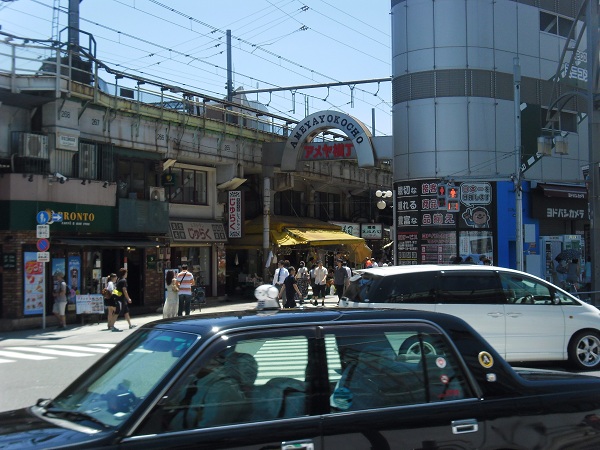
Ameyoko market.
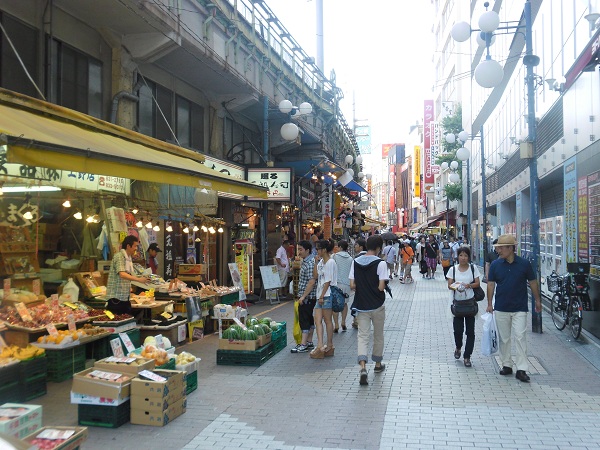
A market that has it all.
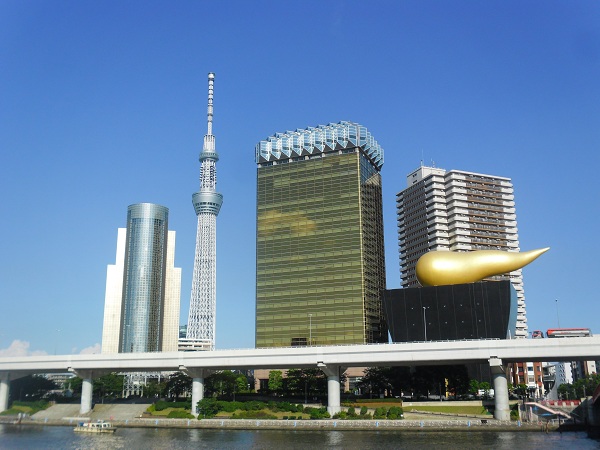
The local brewery and Sky Tower.
Some metro stations later my shoes walked upstairs to a new neighborhood and new challenges. The street scene is slightly different from what I have seen so far in Tokyo's urban life. Cars and people in a neverending flow definitely, but here they are among running taxi cars. For a not too small sum of yen, you can ride a trolley that a Japanese person takes you to the desired destination. Something that may seem a bit strange in this technology-loving country. Surely, one might think that the poor Japanese still could have allowed themselves a better used bike.
The Sensei temple is located a few blocks away and impresses with its divine greatness. Touristing Japanese people queue to reach some kind of altar for a small prayer. Those who do not take it as seriously on either religion or tourist traps stroll lazily around but let themselves still dazzled by the religious traps that are available.
For those who slept through history class in high school swastikas, which pop up here, can feel a little verging on morbid. But for us with education, it is no more than an ordinary feature of temple culture that exists in this part of the world.
For lack of better pursuits I sit down on one of the stairs leading up to the main building. A sightseeing Japanese tourist and his one year-old son will join me and we make small talk for a while. Nothing of importance exchanged but a nice chat is always uplifting for the mood. A moment later we will all be driven away by a temple guard who does not like the general public to hang around on the steps of the sanctuary.
On the way back, I came across a group of albino Japanese substantial dressed to protect themselves from the harsh sun. Hard to be albino in these latitudes, but they seem to thrive. They also appear at McDonalds where I later take refuge for fluid replenishment.
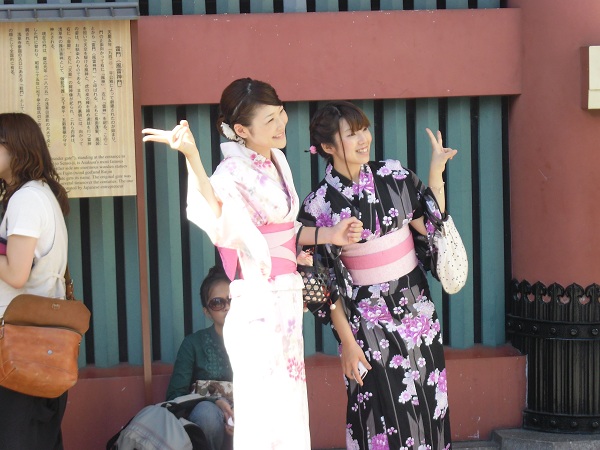
Well-dressed ladies.
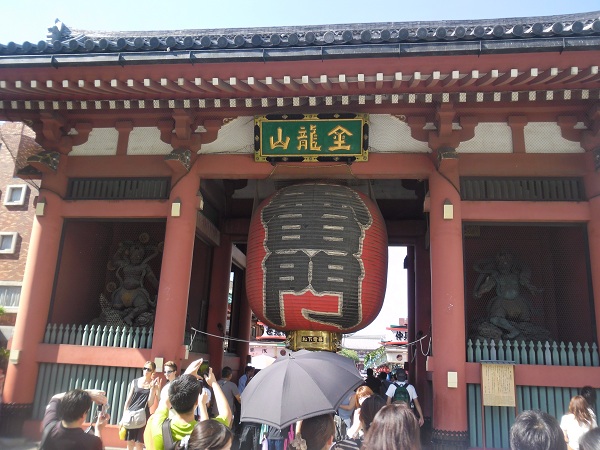
The entrance to the Sensei temple.
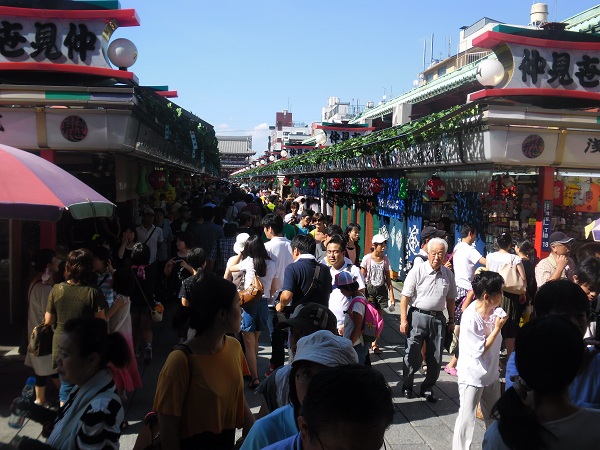
Walking towards the temple.
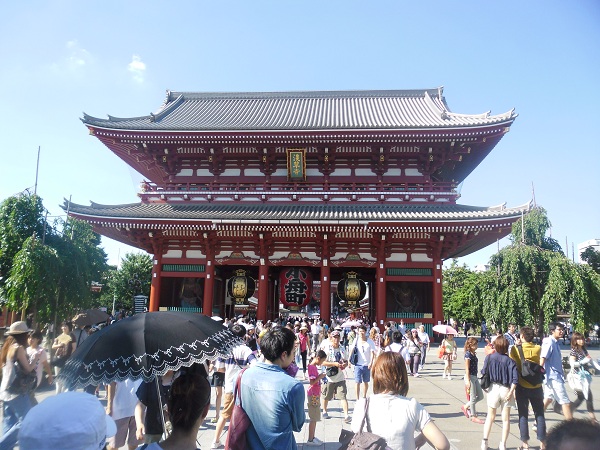
Sensei temple.
The templre has been visited, seen, when I guide my shoes to the river, the same river that I one day earlier looked at further west. Once I get back to witness Japanese engineering at its best. Across the river is a brewery with a giant golden thing on his roof. This shimmering log impresses even a seasoned old beer drinker like me.
I sit a while by the river thinking about my own situation. What do I do next? The river gives me an idea. No grandiose visions that will change the world of history, but still an idea. A little thought, at least change my location to the more peaceful nature. A ferry terminal is at my feet and I decide to move myself by boat westwards. Where, I have only a vague idea. The cardinal direction is determined by the schedule. Which bridge I board will be decided by some other trivial and mundane thing later.
The boat trip is enjoyable and gives a new perspective on the city. A talkative kind old Japanese man sits down next to me, shake hands, and advocate for a moment. Not surprisingly the old man guesses my origin to be western. He lights up like the sun when I say that I'm Swedish. He has in his youth worked in Sweden for a finance firm. He especially remembers the time he went by train between Karlskoga and Stockholm. The train was delayed an hour, a breathtaking amount of time for a Japanese person who is used to set the time for train departures.
The nice Japanese man gave me some tips and tricks on both the evening entertainment and where I should get off the river boat. He suggests a ride on the monorail, a modern light rail that rises several meters above ground. I just need to buy the cheapest ticket to the nearest station. Then I just sit there to the terminus and without stepping off the train I'm going back again, a cheap sightseeing.
Going on the monorail is not bad at all. It takes over an hour through Tokyo's more modern areas. The so often said engineering has apparently got free reign when the new skyscrapers were built. I pass imaginative buildings built on islands that the Japanese themselves have built. The river I for an hour then sailed crossed over the rainbow bridge. All while I was sliding around in the driverless trains, I start to realize the true enjoyment. This costs almost nothing.
After an hour's metro trips, traditional ablution and raw fish intake, I went out like a clubbed seal.
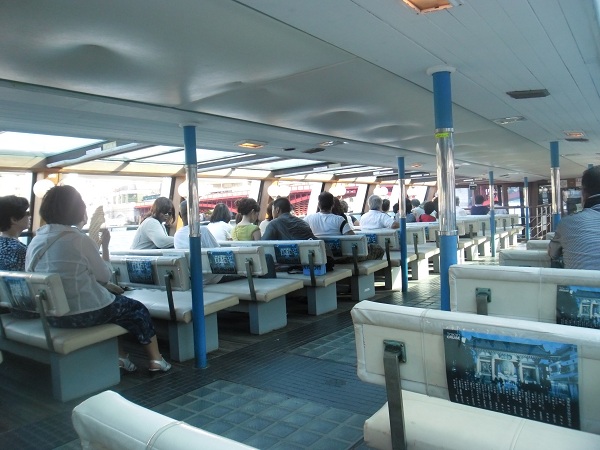
Riverboat adventures this afternoon.
Monday 6th of August
Today is working day for the working people. I wake up as usual without plans and meaning. The capsule for the night is identical to the other capsules I slept in before. The morning toilet is similar to yesterdays, and the Starbucks Breakfast is recognized from yesterday. There is nothing new under the sun except for a persistent rain to turn down the temperature a bit. Today requires, in addition to shoes and bag, one umbrella.
The umbrella sales have started in most street corners, long before I rubbed the gravel from his eyes. Even so, I find just the umbrella that suits my purpose, to keep me reasonably dry. A quick look in the guidebook gives me ideas for the day, technology shopping in Akihabara.
Actually technology shopping in Tokyo is a rather unwarranted activity. Admittedly, my Scandinavian passport gives me tax advantages which removes the VAT, but that little merit is not labeled significantly in the wallet because most are considerably more expensive in Tokyo than in the rest of the world. But technology shopping is not just a quest for the essential stuff for excellent prices. It is as much an experience, a recreational activity that provides values of life, values that can not be valued in money.
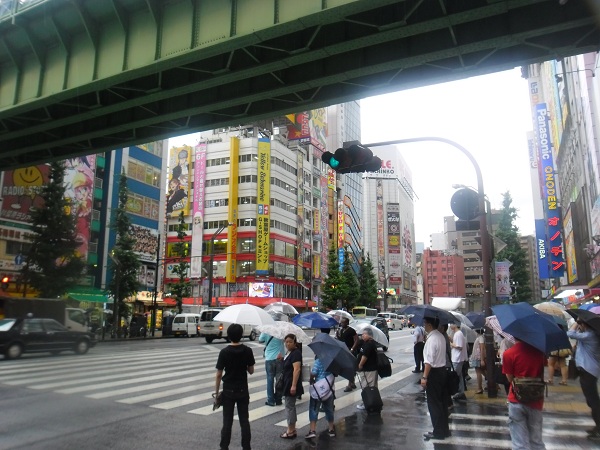
Rain during the technology shopping.
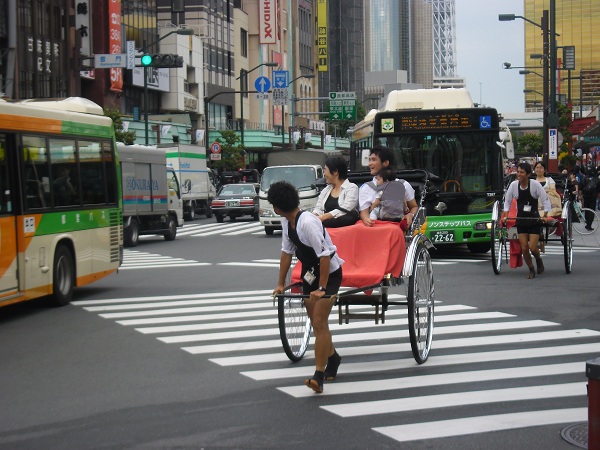
Another way to travel in Tokyo.
The Akihabara district is known for its shops that are filled to the brim of the latest in all technology. Everything from diodes and circuit boards to tablet computers and complicated GPS devices sold to prospective Japanese. Obviously, this is a paradise for the tech-savvy Japanese.
I run around in the shops and markets aimlessly and uncontrollably. Street after street, floor by floor. Here are all kinds of techniques in long lines at prices that probably are a good bit of internet merchants, something that doesn’t bother the busloads of Japanese who in steady stream arrive in Akihabara. Somewhere above the rain-laden clouds the sun is highest when technology hunger starts to subside. I allow the chance to control my shoes a few blocks before I slip into a cafe. Taking $8 for a coffee refill is probably criminal in many countries, but here it is most ordinary and nothing to be proud of. I'm looking absently into the guidebook while I enjoy the expensive drops.
Before the coffee cup is emptied, I decide to return to Asakusa neighborhood, the same part of Tokyo where Sensei temple can be seen. Today is no religious artifacts curls. A tourist information office has called my attention and for lack of better I head there for what might inspire to new Japanese adventure.
The tourist information does not give much. I surfed for a while on their computers. I found out to my disappointment that the western parts of Sweden had been hit by a minor earthquake. Nothing on the Richter scale to write about in the Japanese media, but remarkably high to shake western Swedes. Here I travel halfway around the world to one of the world's most unstable mountain bases without being aware of the slightest vibration. However, it seems Swedish solid bedrock opportunity to shake off while I'm gone. Not to be negative, but probably it is typical.
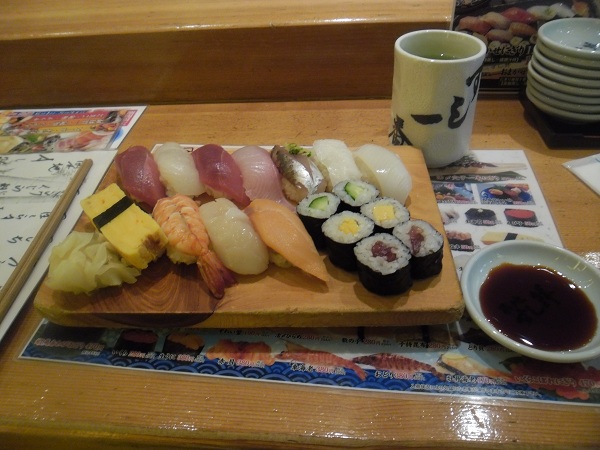
Sushi lunch.
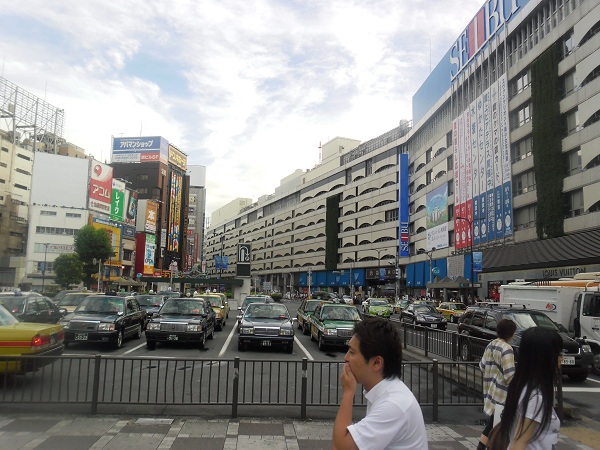
What did he see?
A sushi bar is located in the same street as the tourist office. Since lunchtime long since is passed and past a visit seem just the right. I crash down at a bar. Instead of bartenders and beer taps my view is made up of Japanese chefs with sharp knives which easily slice the raw fish. It will not be long before I have a big tray of assorted types of fish served before me. The price is affordable and delicious dishes. Satisfied with most things I look back up my guidebook. What happens next?
The metro system is something I now fully master and I don’t hesitate to visit yet another neighborhood. Ikebukuro is known for its shopping and even here are there towering skyscrapers against the sky. I make a short visit and walk shortly thereafter into the subway system. Shibuya is next on the agenda.
Shibuya district is located south of Shinjuku. Shibuya station can well compete with Shinjuku but I can not really right up with only two and a half million passengers a day. However, the Shibuya station has a story to tell that leaves no one animal lover’s heart untouched.
Hachiko, the faithful dog waited at the Shibuya station for his owner every day. One day, the owner didn’t come home as he had a stroke earlier in the day, something that Hachiko didn’t know. For nine years the dog faithfully sat and waited until he died on the 8th of March 1935. The cause of death is not clear but heartworm and three chicken skewers in the stomach might have contributed to his death.
Animal friends erected a statue of the dog in golden bronze. Military friends later melt down the statue and incorporate it into the Japanese war machine. After the war, however, the statue was recast there it still stands.
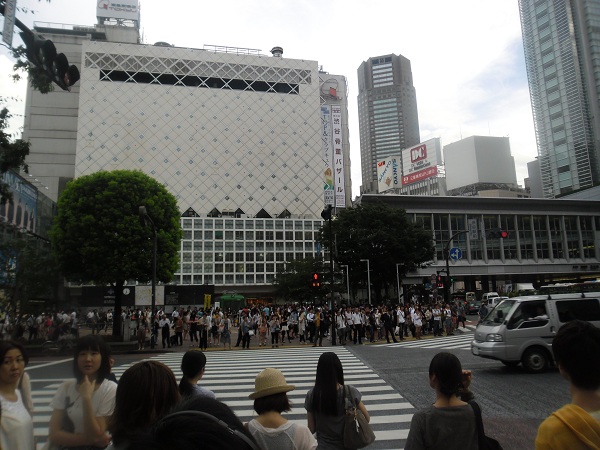
Waiting for green light.
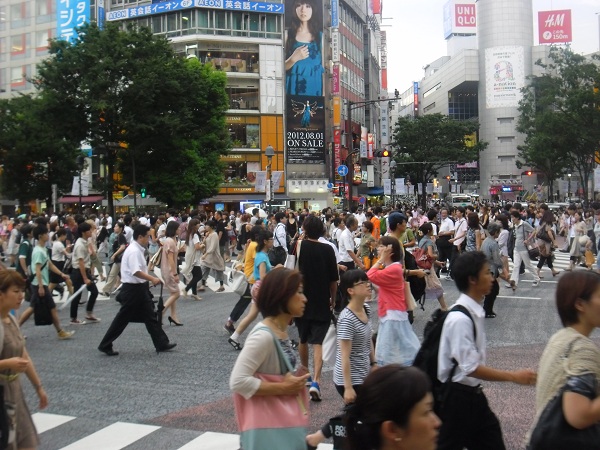
Busy intersection in Shibuya.
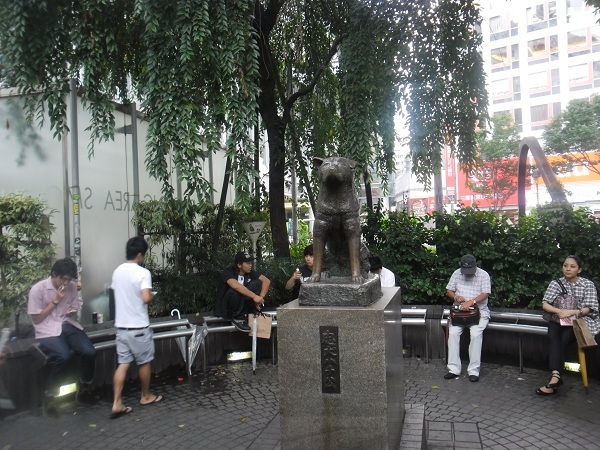
Hachiko, a faithful dog.
Shibuya station's is despite its small size compared to Shinjuku buzzing with Japanese people who are going somewhere. By pure luck I tumble out in front of one of Japan's most famous intersections, the Shibuya crossing. Highways Department in this neighborhood has probably had some overtime hours when the crossing was planned. But it was probably worth it because the intersection is a masterpiece of Japanese communication across disciplines. Like armies hordes of Japanese established in every corner of the street ready to go on the attack. When the traffic signals say go the people storm on simultaneously from all directions. But instead of battlefield chaos the Japanese slip past each other without friction and turmoil.
Everyone comes to where they are going and a few minutes later the traffic roars forward as if nothing has happened. I navigate around the intersection, walk around in the adjoining shopping streets and take some photos of Hachiko and sit on a bench, which amazingly enough is available. Next to me is about twenty Japanese in a smoking area. Not easy being tobacco user in this city.
Evening sneaks up on and it is time to let the fat lady sing. Shinjuku station gets the last word on this day by once again confusing me. I can not find out. In desperation I go out on the west side with some hazy idea of going around the station. After 20 minutes, I have to admit my failure and re-enter the station. A woman who sees my disorientation comes to the rescue. First, she takes me for someone else. After I convinced her that I'm not the one she seeks, she pilots me against the Eastern outputs. After an hour, I finally get out on the right side. Never has it felt so homely and nice to see my capsule.
Tuesday 7th of August
I wake up in my dear capsule one hour before the hotel regulations will force me to check out. I wonder about the next 24 hours before I devote myself to the ritual morning toilet. Should I trust the Japanese efficiency and my navigation skills and get up early the next morning and take the first train out to the airport? To make such an operation work, everything must run smoothly, no wanderings in the Shinjuku station or other miscalculations. The margins are minimal and the room for error is nonexistent. The risk of missing the plane is significant but without mishaps everything should work. The alternative is to get to the airport already tonight.
I decide to check out for the last time. A little sad I submit my key and regain my shoes. I swing up my bag on my back and head towards the station. Before breakfast I buy a ticket to the airport, put my thin´gs in a locker and sit down for a moment to think about my situation.
Coincidence shall control the last day in Tokyo. I choose the metro line from my favorite colour and let some nondescript feeling decide when to get off. It is with mixed feelings I reunite with Ginza.
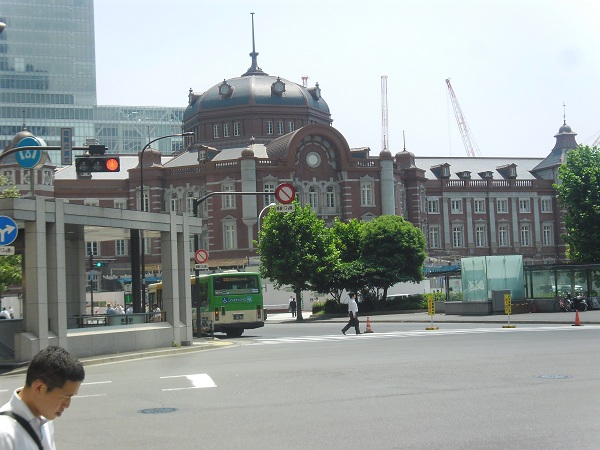
The central station in Tokyo.
After being pushed around in the area around Tokyo Station, I find a cafe. I order an extortionately expensive juice and sit down at a window table. The coolness of the air conditioning and the drink is much needed. This time I let the guidebook be and make my own decision. On this trip, I have travelled by plane, train and boat. Something is missing.
The waitress tries to be helpful in shaky English. And she succeeds. Eventually, I seem to have some knowledge regarding the direction for the next activity.
We are three persons on the city tour bus. I, a Japanese tourist and an American. The bus goes around at a leisurely pace. It is a pleasant way to see Tokyo. Admittedly, it is only a few neighborhoods on this tour, but still it´s pleasant.
After the bus tour the stomach rumbles. The last lunch gives as usual taste buds a rush of satisfaction. I have stopped thinking about what the dishes consist of. I only note that another delicious Japanese lunch has been enjoyed.
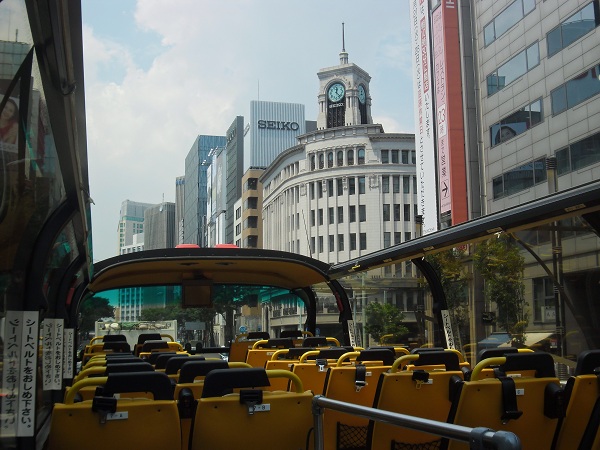
Using the tour bus around Tokyo.
After lunch, the agenda is once again empty. I let my shoes guide my steps. The heat is oppressive, but the man's body has acclimatized. My existence feels pleasant when I slip into a backyard where a café, a square and a small garden pleasant breaks off urban stress. The block appears to be Mitsubishi's old residence. The Square is called Marunouchi brick square. Of course, the coffee shop gets a visit, a ginger ale is ordered. The drink is tasty but it digs a deep hole in your wallet.
The entire block is owned by Mitsubishi and now works as a cultural center. I take this opportunity to soak up some culture ado the next hour. Among other things, I take part of art from Edward Burn-Jones.
Edward is followed by the more intellectual stimulation. A few blocks away, I come across a culture of the larger kind. Japanese engineering has entered into a symbiotic relationship with Japanese artist art. The result stands in front of me, a gigantic house in the form of a ship in glass. I give the impressive building an hour before I sit down on the large inner square, with an expensive juice in his hand. Hours start to run away but there is still a few hours of daylight.
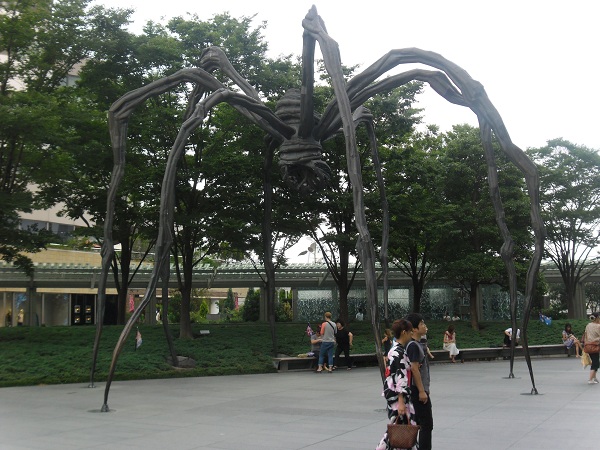
A spider in the park - Roppongi Hills.
Roppongi Hills is a cultural center in the larger format located in the district of Roppongi. Mori Towers is the center that holds everything a culture committed Japanese can dream of. The metro takes me there and I devote an hour to running around in Roppongi Hills cultural area. Impressive views, suspicious art, theaters, cinemas and museums tire out even the most hard-line cultural consumer. The darkness begins to creep up on and I am done with Tokyo. One last metro run and a final error navigation at Shinjuku Station, then it's off to the airport. I'll be there just before Starbucks closes and have time to buy something industrial baked and a coffee. A book, a cup of coffee and a night later, I'm sitting on the plane to the Scandinavian latitudes.
The night is spent at a bench; reading and drinking. Guards and customs personnel ensure that the twenty people who have chosen to spend the night at the airport are at a well-defined area. When morning dawned, it becomes a short visit to one of the toilets. I try looking decent and take the escalators up to the check-in. The Japanese stay is over.